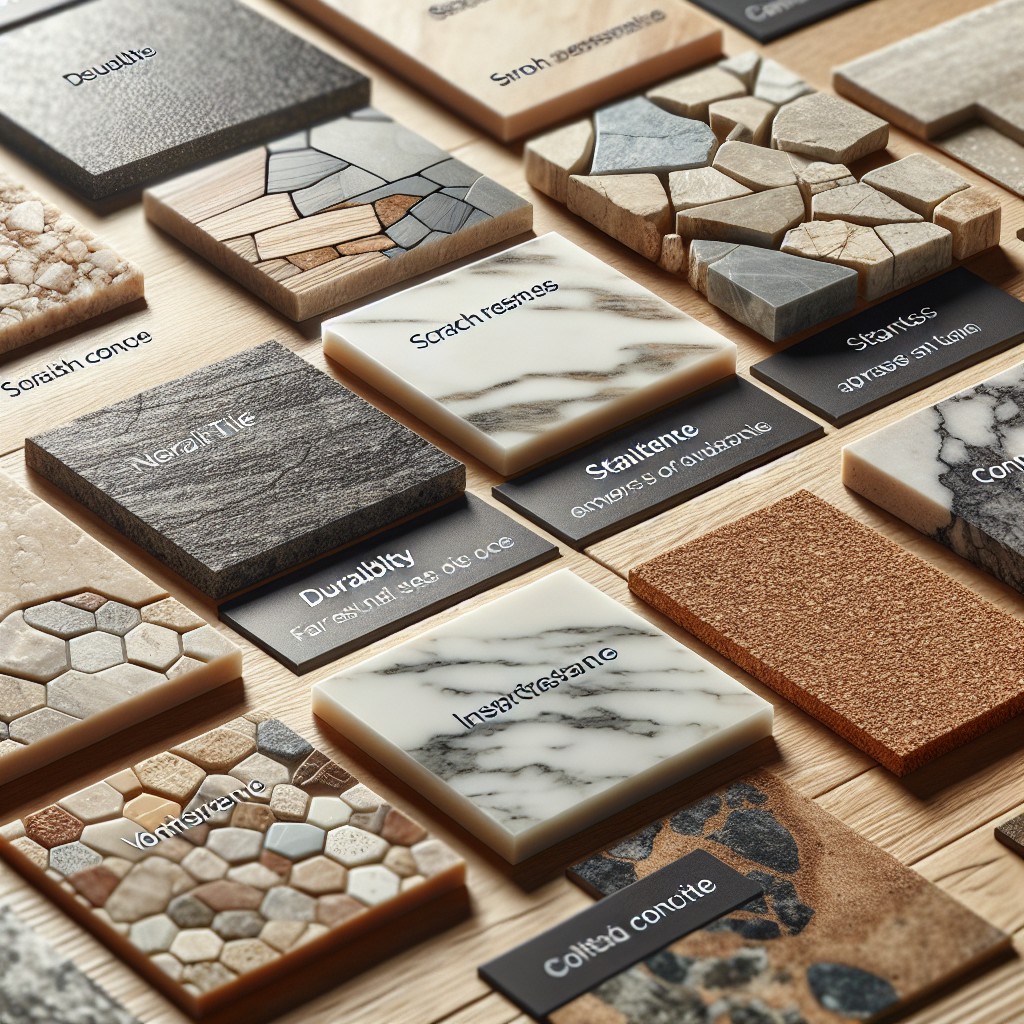Last updated on
Discover the essential qualities and options for the best kitchen flooring to suit durability, style, and your lifestyle needs.
Key takeaways:
- Durability: Consider impact resistance, scratch resistance, and lifespan.
- Easy Cleaning: Non-porous surfaces, tiles, laminate, and grout lines.
- Water Resistance: Porcelain and ceramic tiles, vinyl flooring, and hardwood’s vulnerability.
- Cost: Vinyl and laminate are cost-effective, while natural stone and hardwood vary in price.
- Aesthetic Compatibility: Complement existing cabinetry and fixtures with style and texture.
What's Inside
Durability Assessments

When measuring a kitchen floor’s longevity, several factors come into play. Firstly, consider the impact resistance. Tile, for instance, is known for surviving dropped pots without a dent, whereas vinyl flooring offers some give, preventing breakage of your favorite dishware. Scratch resistance also tops the list, especially for pet owners—hardwood may scratch over time, but tile and high-quality laminate can resist pet claws efficiently.
Another durability factor is the floor’s lifespan. Stone or tile can last decades if properly maintained, while solid hardwood can even outlive the house when refinished periodically. Conversely, vinyl or linoleum offers a shorter life but can be a cost-effective and durable solution when quality and installation are top-notch.
Lastly, fading and stain resistance are crucial in a sun-soaked, spill-prone environment. UV-resistant flooring options, like certain luxury vinyl or ceramic tiles, keep the kitchen looking fresh. Meanwhile, stain resistance is paramount—porous materials like stone might need sealing, while glazed tiles or stain-resistant laminates offer worry-free cleanups after every culinary adventure.
Ease of Cleaning
When tackling the inevitable spills and splatters, some floors prove to be allies, allowing for swift and stress-free cleanups. Consider floors with non-porous surfaces, which prevent stains from lingering by enabling a quick wipe to restore your kitchen’s cleanliness. Tiles, both ceramic and porcelain, are champions in this arena, with their glaze acting as a shield against stains. Similarly, luxury vinyl stands out for not only resisting water but also for its simple maintenance—most messes are handled with a damp mop.
On the other hand, hardwood floors, while warm and inviting, demand a bit more diligence with immediate wipe-ups to prevent water damage or staining. For those seeking the look of wood with less upkeep, laminate flooring can mimic this aesthetic and provide an easier cleaning experience, provided the seams are well-sealed.
Beyond the surface type, consider grout lines. Wider grout can harbor grime and require more elbow grease to stay pristine. Opt for darker grout to conceal dirt or choose a floor with minimal grout lines to simplify the task.
Remember, a floor that’s easy to clean will save time and energy in the long run, allowing you to enjoy your kitchen more and worry less about the aftermath of cooking and entertaining.
Water Resistance Evaluation
In the realm of kitchen floors, grappling with spills is a daily affair. Thus, the priority on water resistance can’t be overstated. Porcelain and ceramic tiles take the lead for their impervious nature, offering peace of mind during the most chaotic cooking sessions. They’re practically immune to puddles of water, only requiring a quick wipe.
Vinyl flooring, both in sheet and luxury vinyl tile (LVT) formats, is another champion of moisture resistance. Upgraded versions come with waterproof cores, tailored for the messiest of kitchens.
On the flip side, hardwood’s natural beauty comes with a catch—it’s susceptible to water damage. While sealants and finishes diminish this vulnerability, it’s crucial to mop up spills promptly to prevent warping. And let’s not forget natural stone—though stunning, it often demands sealing to fend off water stains and damage.
In considering your options, weigh each material’s relationship with water against your kitchen’s traffic and your readiness to jump into clean-up mode when splashes strike. Remember, the right choice is not just about surviving drips and splashes but also about maintaining the floor’s integrity over countless damp encounters.
Cost Considerations
Evaluating flooring options without considering budget constraints would be like planning a meal without checking your pantry; it’s essential to know what ingredients you have before you start cooking. When it comes to your kitchen floor, the materials can vary widely in price. For example, vinyl and laminate solutions offer a cost-effective way to achieve a high-end look without breaking the bank. They are relatively inexpensive, easy on the wallet for both materials and installation.
On the other end of the spectrum, natural stone like granite or marble presents an opulent finish but comes with a heftier price tag for both purchase and installation due to the skill required to lay it properly. Hardwood floors, a perennial favorite for their warmth and classic appeal, fall somewhere in the middle, with costs varying significantly based on wood type and quality.
Remember, while initial costs are important, so are the long-term expenses. Cheaper flooring might need more frequent replacements, whereas pricier options could offer durability that saves money over time. Always weigh the upfront investment against the expected lifespan and maintenance to calculate the most economically sound decision for your kitchen.
Aesthetic Compatibility
When selecting a kitchen floor, consider how it complements existing cabinetry, appliances, and fixtures. Harmony reigns in design, so opt for materials that resonate with your kitchen’s style theme. Dark woods often enhance traditional decors, while polished concrete or terrazzo can mirror a more modern, industrial aesthetic.
Texture also plays a role; rough-hewn stone adds rustic charm, while sleek ceramic provides a contemporary edge. For continuity, think about extending the flooring to adjoining areas, making smaller spaces appear larger. Also, don’t forget underfoot comfort and the potential need for anti-fatigue mats in high-traffic prep areas.
Remember, the aim is to achieve visual flow and cohesion, thereby creating a welcoming and visually pleasing environment that reflects your personal taste.




